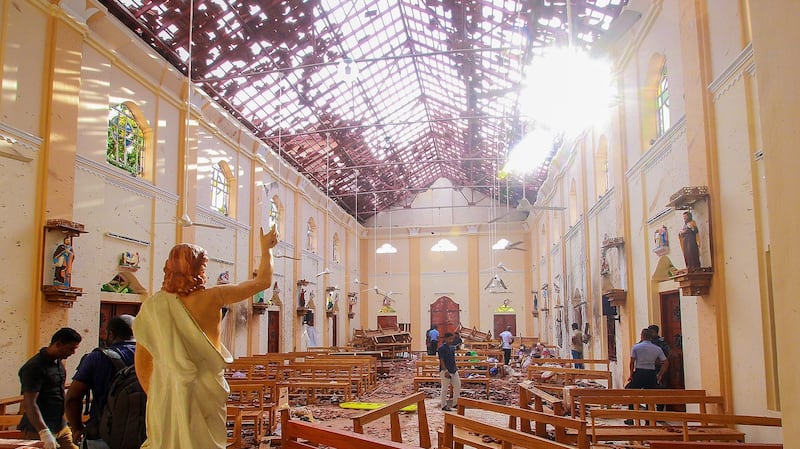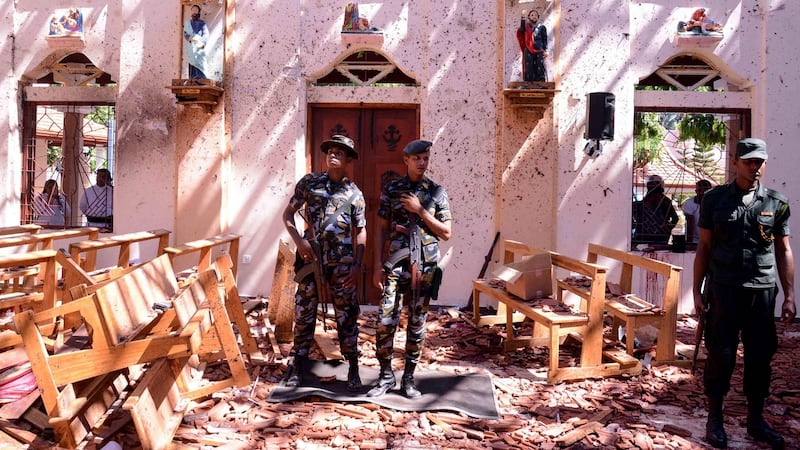Set back from a strip of golden sand and the shimmering sea, beyond the groves of palm trees heavy with coconuts, the Roman Catholic church in the small town of Negombo had been a place of calm devotion amid the colour, vibrancy and noise of Sri Lanka for more than 200 years.
Then on Sunday morning, St Sebastian’s became a place of chaos, pain and death. At about 8.45am, explosives sent shards of metal and debris into the worshippers crowded on its wooden pews to celebrate Mass. The blast was so powerful it destroyed much of the building’s roof, leaving shattered tiles among the casualties slumped across the floor.
“A bomb attack to our church please come and help if your family members are there,” read a plaintive post on social media.
Almost simultaneously, there was a blast in another church: St Anthony’s Shrine in the Sri Lankan capital, Colombo. It too left a scene of devastation with shattered icons, blood-spattered clothes and burns scorched on to walls by the intense heat of explosions. Then, in the eastern port city of Batticaloa, a third church was hit by a devastating attack, with the same appalling affect.
As panicked worshippers tried to help the wounded, reports came in of further attacks against hotels in Colombo. At the luxury Cinnamon Grand, right in the centre of the city and close to the official residence of President Maithripala Sirisena, guests were filling the popular Taprobane restaurant on the ground floor, known for its spectacular seafood buffet and copious brunch offerings.
Powerful bomb
The hotel was having one of its busiest days of the year with the Easter holiday weekend, full of foreign holidaymakers and locals from Colombo’s well-heeled elite.
There had seemed nothing remarkable about the man as he queued at the buffet, plate in hand. He had checked in the night before, giving his name as Mohamed Azzam Mohamed and a false address. He had said he was in town for business. But just as he was about to be served, he set off a powerful bomb inside the packed restaurant.
“There was utter chaos,” said one hotel employee, who spoke on condition of anonymity. “It was busy. It was families,” the employee said. “One of our managers who was welcoming guests was among those killed instantly.”
The bomber also died. Parts of his body were later recovered from the scene by police.

Two other luxury hotels, the Shangri-La and the Kingsbury, were also attacked at about the same time.
At the Shangri-La, witnesses said they heard two loud blasts. Security camera footage showed two men detonating devices in the Table One restaurant and a hotel corridor. Witnesses saw extensive damage to the second floor at the hotel, with windows blown out and electrical wires hanging from the ceiling.
“We are deeply saddened and shocked by the incident and our thoughts and prayers are with the families of the casualties and those who have been affected,” a statement from the Shangri-La said.
‘Grief and mourning’
The Kingsbury is also one of Colombo’s most expensive hotels, located near the city’s World Trade Centre. The toll there was unclear.
In a statement on its Facebook page, the hotel said: “On behalf of the entire Kingsbury team, we share in the shock, grief and mourning of our entire nation in the aftermath of the recent attack.”
The wave of appalling violence – all the attacks appeared to involve suicide bombers – had lasted less than an hour. By its end, more than 200 people were dead, and 500 were injured. Brought in ambulances, private cars, rickshaws or carried on makeshift stretchers, the casualties overwhelmed local hospitals.
Sri Lanka is no stranger to violence. The scale of the bloodshed recalled the worst days of the nation’s decades-long civil war, in which the Tamil Tigers – a violent separatist group from the ethnic Tamil minority – sought independence from the Buddhist-majority country. During the war, which ended almost exactly a decade ago, the Tigers and other rebels carried out many bombings. Few remembered similar carnage however.
Alongside Sri Lankans caught in the blasts were dozens of foreigners – no surprise given the attraction of the island nation’s beaches, rich culture and climate in the decade of relative stability since the end of the civil war.
It soon became clear many visitors from overseas were among the casualties. A national hospital spokesman said that doctors there were treating citizens from India, Portugal and Turkey, and five from the UK.
Curfew imposed
As rescue workers and ordinary people rushed to help, security forces launched a massive operation to find those responsible and prevent further strikes. An overnight curfew was declared and social media restricted to prevent the circulation of inflammatory material.
Though the attackers appeared to have been killed in the blasts, there were fears others might be waiting to launch a second wave of attacks. It was clear that an operation to launch so many simultaneous attacks involved a large support network that investigators urgently needed to unravel, one police official said.
An indication that security forces might be closing in on remaining perpetrators emerged about three hours after the attacks came. An explosion was heard at a guesthouse near the national zoo in Colombo’s Dehiwala neighbourhood. A number of people were arrested at the address, some of whom were seriously injured. Shortly afterwards, three police officers were killed while conducting a search of a suspected safe house in Dematagoda, on the outskirts of the city. The occupants of the safe house appeared to have detonated explosives to prevent their arrest, said the defence minister, Ruwan Wijewardene. He described the wave of bombings as a terrorist attack by religious extremists.

There was no immediate claim of responsibility for the attacks, but Sri Lanka has experienced rising sectarian tension in recent years.
About 1.2 million of Sri Lanka’s 21 million inhabitants are Catholics, and these include members of both major ethnicities, the Sinhalese majority and the Tamil minority.
In recent years, there have been clashes between the majority Buddhist community and minority Muslims, and in March last year the government imposed a 12-day state of emergency to quell anti-Muslim riots. Christian groups have also reported increased harassment from hardline Buddhist groups.
Social tensions
Prime minister Ranil Wickremesinghe said he feared the violence could trigger instability and vowed the government will “vest all necessary powers with the defence forces” to take action against those responsible for the massacre “regardless of their stature”.
Though observers have expressed concerns that Sri Lanka’s lawmakers have not done enough to reduce social tensions, many visitors to the island nation are impressed by the apparent harmony between ethnic and religious communities.
“Apart from the tragedy of the immediate victims of the bombings, I worry that these terrible events will set the country back significantly,” said Peter Kelson, a technology manager from Sydney on holiday in Negombo when the attack occurred.
“Having experienced the open and welcoming Sri Lanka during my last week travelling through the country, I had a sense that the country was turning the corner.”
Others were inspired by the sight of hundreds – Hindus, Christians, Muslims, Buddhists, Tamils and Sinhalese – who rushed to hospitals and clinics to give blood.
“Everyone had just one intention and that was to help the victims of the blast, no matter what religion or race they may be,” Usman Ali, a Colombo resident, told the BBC. – Guardian













